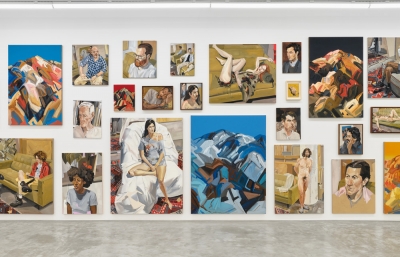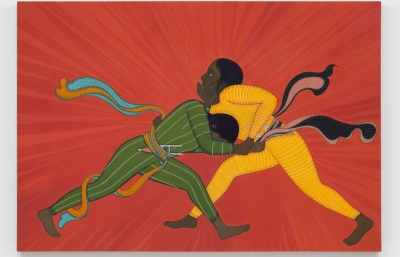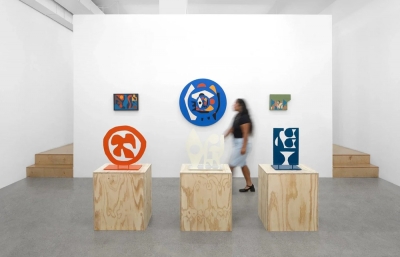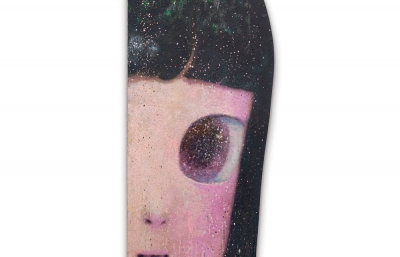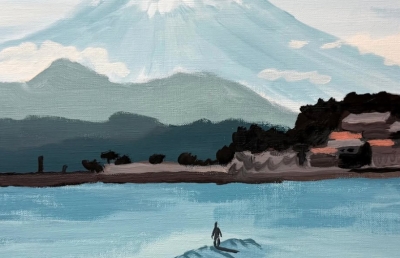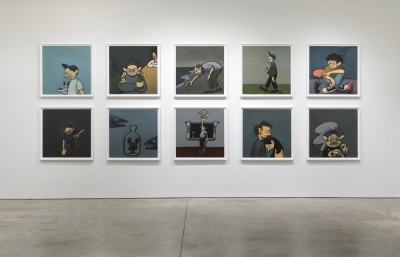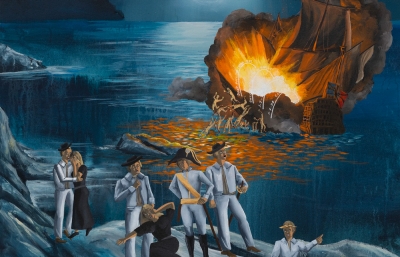Entrance announces Maxwell Sykes’ eponymous solo exhibition, on view at 48 Ludlow Street from Wednesday, September 3 through October 11, 2025.
A pair of rectangular planes, a triangle. From there, a single block, a closer crop, a new form created by the convergence of two shapes. Sometimes the planes multiply: a line cleaving down the center splits one open; stacked horizontal bands barricade top from bottom. Pure, austere geometry dissolves in palpable brushstrokes and slight, sloping asymmetry.
And color. Canary yellow on a buttery ground, sun-warmed ivory against muddied gold. Innumerable shades of blue, each electric, each emitting its own charge. But just as geometry, here, is imperfect, these forms are not truly monochromatic. Underpaintings in altogether different hues appear in glimpses—in the rifts between strokes, behind thin washes of oil, or revealed through careful scoring.
When Maxwell Sykes moved to New York from his hometown of Los Angeles a year and a half ago, he found himself living on the edge of Madison Square Park. This micro-neighborhood is home to the flagship Shake Shack (the people’s Tavern on the Green) and the Flatiron building, perennially shrouded in scaffolding. But framed by Sykes’ window is another architectural marvel, the glitter of its gilded, pyramidal roof ricocheting off its surroundings. Built in 1927–28, the New York Life building was a Gothic Revival aberration in a skyline newly blooming with Art Deco cloud-grazers. Nearly a century later, looking out daily onto that gold-dipped structure—now an anomaly in an entirely different architectural landscape—Sykes began a series of paintings.
The oils on canvas here, a selection from that ongoing body of work, begin with that view. But the New York Life building is not depicted in Sykes’ paintings—parts of it have been distilled, others fragmented and reassembled, still other elements merged by the impressionistic haze of memory with different buildings seen from that same window. While intimate in their evocation of time, of a devotional form of looking, of an idea of home, these works are studies in gesture, composition, and color. Like those less tangible undercurrents (time, home, and looking), color is relational—constituted and changed by those around it, transformed by darkness or light. It’s also altered, associatively, by its form. Here, a fluted swath of white could be a marble column, the same hue contained by a halved triangle might evoke a sail.
Often, the particular slice of outdoors delineated by the four sides of a window recedes into the background, as familiar as the enclosure of walls and belongings that separate us from it. But this familiarity is inflected with a special kind of intimacy: in the morning, at night, over weeks and seasons, the image made by your window is all yours, yet totally unpossessable. Returning again and again to that vista, Sykes’ aim is not to capture it, but to distill in paint those chosen elements that are all his own. —Sophia Larigakis









